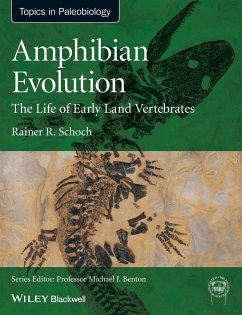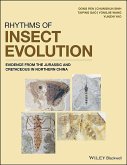Rainer R Schoch
Amphibian Evolution
Rainer R Schoch
Amphibian Evolution
- Broschiertes Buch
- Merkliste
- Auf die Merkliste
- Bewerten Bewerten
- Teilen
- Produkt teilen
- Produkterinnerung
- Produkterinnerung
This book focuses on the first vertebrates to conquer land and their long journey to become fully independent from the water. It traces the origin of tetrapod features and tries to explain how and why they transformed into organs that permit life on land. Although the major frame of the topic lies in the past 370 million years and necessarily deals with many fossils, it is far from restricted to paleontology. The aim is to achieve a comprehensive picture of amphibian evolution. It focuses on major questions in current paleobiology: how diverse were the early tetrapods? In which environments…mehr
Andere Kunden interessierten sich auch für
![Rhythms of Insect Evolution Rhythms of Insect Evolution]() Rhythms of Insect Evolution230,99 €
Rhythms of Insect Evolution230,99 €![A New Silurian (Llandovery, Telychian) Sponge Assemblage from Gotland, Sweden A New Silurian (Llandovery, Telychian) Sponge Assemblage from Gotland, Sweden]() Freek RhebergenA New Silurian (Llandovery, Telychian) Sponge Assemblage from Gotland, Sweden23,99 €
Freek RhebergenA New Silurian (Llandovery, Telychian) Sponge Assemblage from Gotland, Sweden23,99 €![Special Papers in Palaeontology, Trilobites from the Silurian Reefs in North Greenland Special Papers in Palaeontology, Trilobites from the Silurian Reefs in North Greenland]() Special Papers in Palaeontology, Trilobites from the Silurian Reefs in North Greenland81,99 €
Special Papers in Palaeontology, Trilobites from the Silurian Reefs in North Greenland81,99 €![Special Papers in Palaeontology, Conodont Biology and Phylogeny Special Papers in Palaeontology, Conodont Biology and Phylogeny]() Mark A PurnellSpecial Papers in Palaeontology, Conodont Biology and Phylogeny124,99 €
Mark A PurnellSpecial Papers in Palaeontology, Conodont Biology and Phylogeny124,99 €![Lower Ordovician Trilobites of the Kirtonryggen Formation, Spitsbergen Lower Ordovician Trilobites of the Kirtonryggen Formation, Spitsbergen]() Richard A ForteyLower Ordovician Trilobites of the Kirtonryggen Formation, Spitsbergen45,99 €
Richard A ForteyLower Ordovician Trilobites of the Kirtonryggen Formation, Spitsbergen45,99 €![Late Ordovician Brachiopods from West-Central Alaska Late Ordovician Brachiopods from West-Central Alaska]() Christian M O RasmussenLate Ordovician Brachiopods from West-Central Alaska45,99 €
Christian M O RasmussenLate Ordovician Brachiopods from West-Central Alaska45,99 €![Special Papers in Palaeontology, Studies on Fossil Tetrapods Special Papers in Palaeontology, Studies on Fossil Tetrapods]() Special Papers in Palaeontology, Studies on Fossil Tetrapods114,99 €
Special Papers in Palaeontology, Studies on Fossil Tetrapods114,99 €-
-
-
This book focuses on the first vertebrates to conquer land and their long journey to become fully independent from the water. It traces the origin of tetrapod features and tries to explain how and why they transformed into organs that permit life on land. Although the major frame of the topic lies in the past 370 million years and necessarily deals with many fossils, it is far from restricted to paleontology. The aim is to achieve a comprehensive picture of amphibian evolution. It focuses on major questions in current paleobiology: how diverse were the early tetrapods? In which environments did they live, and how did they come to be preserved? What do we know about the soft body of extinct amphibians, and what does that tell us about the evolution of crucial organs during the transition to land? How did early amphibians develop and grow, and which were the major factors of their evolution? The Topics in Paleobiology Series is published in collaboration with the Palaeontological Association, and is edited by Professor Mike Benton, University of Bristol.
Hinweis: Dieser Artikel kann nur an eine deutsche Lieferadresse ausgeliefert werden.
Hinweis: Dieser Artikel kann nur an eine deutsche Lieferadresse ausgeliefert werden.
Produktdetails
- Produktdetails
- Verlag: Wiley
- Seitenzahl: 304
- Erscheinungstermin: 5. Mai 2014
- Englisch
- Abmessung: 246mm x 189mm x 17mm
- Gewicht: 573g
- ISBN-13: 9780470671788
- ISBN-10: 0470671785
- Artikelnr.: 40720724
- Herstellerkennzeichnung
- Libri GmbH
- Europaallee 1
- 36244 Bad Hersfeld
- gpsr@libri.de
- Verlag: Wiley
- Seitenzahl: 304
- Erscheinungstermin: 5. Mai 2014
- Englisch
- Abmessung: 246mm x 189mm x 17mm
- Gewicht: 573g
- ISBN-13: 9780470671788
- ISBN-10: 0470671785
- Artikelnr.: 40720724
- Herstellerkennzeichnung
- Libri GmbH
- Europaallee 1
- 36244 Bad Hersfeld
- gpsr@libri.de
Rainer Schoch, born 1970 in Ludwigshafen, Germany. He graduated at the University of Tübingen, undertook field work in Argentina and the USA, and worked as a curator and assistant professor at Humboldt University Berlin. Since 2003 he has been the curator of amphibians and reptiles at the Natural History Museum of Stuttgart, Germany.
Preface viii
Acknowledgments x
1 Introduction 1
1.1 Changing paradigms in amphibian evolution 3
1.2 Paleobiology: data, methods, and time scales 5
1.3 Concepts and metaphors: how scientists "figure out" problems 7
1.4 Characters and phylogenies 8
1.5 What's in a name? 8
References 11
2 The Amphibian World: Now and Then 13
2.1 Tetrapoda 14
2.1.1 The tetrapod skeleton 14
2.1.2 Tetrapod characters 23
2.1.3 Stem-tetrapods (Tetrapodomorpha) 25
2.1.4 Carboniferous tetrapods or tetrapodomorphs? 31
2.2 The amniote stem-group 32
2.2.1 Anthracosauria 33
2.2.2 Seymouriamorpha 37
2.2.3 Chroniosuchia 38
2.2.4 Lepospondyli 40
2.2.4.1 Lepospondyl characters 42
2.2.4.2 Microsauria 42
2.2.4.3 Lysorophia 44
2.2.4.4 Nectridea 44
2.2.4.5 Aïstopoda 45
2.2.4.6 Adelospondyli 46
2.2.4.7 Acherontiscidae 46
2.2.5 Gephyrostegida 46
2.2.6 Amniota 47
2.2.6.1 Stem-amniotes and early crown amniotes 48
2.3 The lissamphibian stem-group (Temnospondyli) 48
2.3.1 Edopoidea 51
2.3.2 Dendrerpeton and Balanerpeton 53
2.3.3 Dvinosauria 54
2.3.4 Dissorophoidea and Zatracheidae 54
2.3.5 Eryopoidea 56
2.3.6 Stereospondyli 57
2.4 Albanerpetontidae 58
2.5 Lissamphibia 59
2.5.1 Lissamphibian characters 61
2.5.2 Batrachia 62
2.5.2.1 Anura (frogs and toads) 62
2.5.2.2 Caudata (salamanders) 67
2.5.2.3 Gymnophiona (caecilians) 68
References 70
3 Amphibian Life Through Time 81
3.1 Aquatic predators prepare for land 83
3.2 Hot springs, scorpions, and little creepers 83
3.3 Life in the tropical coal forest 85
3.4 Neotenes explore unfavorable waters 89
3.5 Lowlands, uplands, and a cave 90
3.6 Hide and protect: extreme life in the hothouse 94
3.7 Predators in deltas, lakes, and brackish swamps 97
3.8 Stereospondyls in refugia, lissamphibians on the rise 97
3.9 Batrachians diversify, stereospondyls disappear 100
3.10 Lissamphibians expand into diverse habitats 101
References 102
4 The Amphibian Soft Body 106
4.1 How to infer soft tissues in extinct taxa 107
4.2 Fossil evidence: soft tissue preservation 109
4.3 Head and visceral skeleton 110
4.4 Respiratory organs 113
4.5 Lateral lines, electroreception, and ears 118
References 122
5 Evolution of Functional Systems 126
5.1 How paradigms and brackets give a functional scenario 127
5.2 Feeding and breathing under water 131
5.3 Decoupling breathing and feeding 134
5.4 Hearing: exapting the spiracle and hyomandibula 136
5.5 Respiration in early tetrapods 141
5.6 The evolution of terrestrial feeding 143
5.7 Transforming fins into limbs 144
5.8 Locomotion in paleozoic tetrapods 146
References 148
6 Development and Evolution 152
6.1 Ontogeny in modern amphibians 153
6.2 Fossil ontogenies 158
6.3 Ontogeny as a sequence: developmental trajectories 163
6.4 Histology: the skeleton as archive 167
6.5 Changing shape: allometry 171
6.6 Heterochrony: the evolution of development 174
6.7 Body plans: gene regulation and morphogenesis 179
References 184
7 Paleoecology 191
7.1 Lissamphibian ecology 192
7.2 Paleoecology: problems and perspectives 193
7.3 Paleozoic and Mesozoic amphibians 196
7.4 Amphibian evolution as a walk through trophic levels 203
References 205
8 Life History Evolution 208
8.1 Plasticity, reaction norm, and canalization 209
8.2 Reaction norms in extant amphibians 210
8.3 The biphasic life cycle in lissamphibians 211
8.4 Seymouriamorphs: biphasic life cycles without metamorphosis 213
8.5 Temnospondyls: flexible uni- and biphasic ontogenies 213
8.6 Lepospondyls: dwarfism and uniphasic life cycles 215
8.7 The evolution of metamorphosis 216
8.8 The evolution of neoteny 216
8.9 General features of life history evolution 217
References 219
9 Phylogeny 222
9.1 Phylogeny of amphibians 223
9.2 The big picture: tetrapod diversification 223
9.3 The origin of lissamphibians 224
References 231
10 Macroevolution 234
10.1 What is macroevolution? 235
10.2 Patterns of early tetrapod evolution 235
10.3 Major factors of amphibian evolution 240
10.4 Clades, space, and time 248
10.5 Diversity, disparity, and extinction 249
10.6 The evolution of terrestriality 252
References 254
Index 260
Acknowledgments x
1 Introduction 1
1.1 Changing paradigms in amphibian evolution 3
1.2 Paleobiology: data, methods, and time scales 5
1.3 Concepts and metaphors: how scientists "figure out" problems 7
1.4 Characters and phylogenies 8
1.5 What's in a name? 8
References 11
2 The Amphibian World: Now and Then 13
2.1 Tetrapoda 14
2.1.1 The tetrapod skeleton 14
2.1.2 Tetrapod characters 23
2.1.3 Stem-tetrapods (Tetrapodomorpha) 25
2.1.4 Carboniferous tetrapods or tetrapodomorphs? 31
2.2 The amniote stem-group 32
2.2.1 Anthracosauria 33
2.2.2 Seymouriamorpha 37
2.2.3 Chroniosuchia 38
2.2.4 Lepospondyli 40
2.2.4.1 Lepospondyl characters 42
2.2.4.2 Microsauria 42
2.2.4.3 Lysorophia 44
2.2.4.4 Nectridea 44
2.2.4.5 Aïstopoda 45
2.2.4.6 Adelospondyli 46
2.2.4.7 Acherontiscidae 46
2.2.5 Gephyrostegida 46
2.2.6 Amniota 47
2.2.6.1 Stem-amniotes and early crown amniotes 48
2.3 The lissamphibian stem-group (Temnospondyli) 48
2.3.1 Edopoidea 51
2.3.2 Dendrerpeton and Balanerpeton 53
2.3.3 Dvinosauria 54
2.3.4 Dissorophoidea and Zatracheidae 54
2.3.5 Eryopoidea 56
2.3.6 Stereospondyli 57
2.4 Albanerpetontidae 58
2.5 Lissamphibia 59
2.5.1 Lissamphibian characters 61
2.5.2 Batrachia 62
2.5.2.1 Anura (frogs and toads) 62
2.5.2.2 Caudata (salamanders) 67
2.5.2.3 Gymnophiona (caecilians) 68
References 70
3 Amphibian Life Through Time 81
3.1 Aquatic predators prepare for land 83
3.2 Hot springs, scorpions, and little creepers 83
3.3 Life in the tropical coal forest 85
3.4 Neotenes explore unfavorable waters 89
3.5 Lowlands, uplands, and a cave 90
3.6 Hide and protect: extreme life in the hothouse 94
3.7 Predators in deltas, lakes, and brackish swamps 97
3.8 Stereospondyls in refugia, lissamphibians on the rise 97
3.9 Batrachians diversify, stereospondyls disappear 100
3.10 Lissamphibians expand into diverse habitats 101
References 102
4 The Amphibian Soft Body 106
4.1 How to infer soft tissues in extinct taxa 107
4.2 Fossil evidence: soft tissue preservation 109
4.3 Head and visceral skeleton 110
4.4 Respiratory organs 113
4.5 Lateral lines, electroreception, and ears 118
References 122
5 Evolution of Functional Systems 126
5.1 How paradigms and brackets give a functional scenario 127
5.2 Feeding and breathing under water 131
5.3 Decoupling breathing and feeding 134
5.4 Hearing: exapting the spiracle and hyomandibula 136
5.5 Respiration in early tetrapods 141
5.6 The evolution of terrestrial feeding 143
5.7 Transforming fins into limbs 144
5.8 Locomotion in paleozoic tetrapods 146
References 148
6 Development and Evolution 152
6.1 Ontogeny in modern amphibians 153
6.2 Fossil ontogenies 158
6.3 Ontogeny as a sequence: developmental trajectories 163
6.4 Histology: the skeleton as archive 167
6.5 Changing shape: allometry 171
6.6 Heterochrony: the evolution of development 174
6.7 Body plans: gene regulation and morphogenesis 179
References 184
7 Paleoecology 191
7.1 Lissamphibian ecology 192
7.2 Paleoecology: problems and perspectives 193
7.3 Paleozoic and Mesozoic amphibians 196
7.4 Amphibian evolution as a walk through trophic levels 203
References 205
8 Life History Evolution 208
8.1 Plasticity, reaction norm, and canalization 209
8.2 Reaction norms in extant amphibians 210
8.3 The biphasic life cycle in lissamphibians 211
8.4 Seymouriamorphs: biphasic life cycles without metamorphosis 213
8.5 Temnospondyls: flexible uni- and biphasic ontogenies 213
8.6 Lepospondyls: dwarfism and uniphasic life cycles 215
8.7 The evolution of metamorphosis 216
8.8 The evolution of neoteny 216
8.9 General features of life history evolution 217
References 219
9 Phylogeny 222
9.1 Phylogeny of amphibians 223
9.2 The big picture: tetrapod diversification 223
9.3 The origin of lissamphibians 224
References 231
10 Macroevolution 234
10.1 What is macroevolution? 235
10.2 Patterns of early tetrapod evolution 235
10.3 Major factors of amphibian evolution 240
10.4 Clades, space, and time 248
10.5 Diversity, disparity, and extinction 249
10.6 The evolution of terrestriality 252
References 254
Index 260
Preface viii
Acknowledgments x
1 Introduction 1
1.1 Changing paradigms in amphibian evolution 3
1.2 Paleobiology: data, methods, and time scales 5
1.3 Concepts and metaphors: how scientists "figure out" problems 7
1.4 Characters and phylogenies 8
1.5 What's in a name? 8
References 11
2 The Amphibian World: Now and Then 13
2.1 Tetrapoda 14
2.1.1 The tetrapod skeleton 14
2.1.2 Tetrapod characters 23
2.1.3 Stem-tetrapods (Tetrapodomorpha) 25
2.1.4 Carboniferous tetrapods or tetrapodomorphs? 31
2.2 The amniote stem-group 32
2.2.1 Anthracosauria 33
2.2.2 Seymouriamorpha 37
2.2.3 Chroniosuchia 38
2.2.4 Lepospondyli 40
2.2.4.1 Lepospondyl characters 42
2.2.4.2 Microsauria 42
2.2.4.3 Lysorophia 44
2.2.4.4 Nectridea 44
2.2.4.5 Aïstopoda 45
2.2.4.6 Adelospondyli 46
2.2.4.7 Acherontiscidae 46
2.2.5 Gephyrostegida 46
2.2.6 Amniota 47
2.2.6.1 Stem-amniotes and early crown amniotes 48
2.3 The lissamphibian stem-group (Temnospondyli) 48
2.3.1 Edopoidea 51
2.3.2 Dendrerpeton and Balanerpeton 53
2.3.3 Dvinosauria 54
2.3.4 Dissorophoidea and Zatracheidae 54
2.3.5 Eryopoidea 56
2.3.6 Stereospondyli 57
2.4 Albanerpetontidae 58
2.5 Lissamphibia 59
2.5.1 Lissamphibian characters 61
2.5.2 Batrachia 62
2.5.2.1 Anura (frogs and toads) 62
2.5.2.2 Caudata (salamanders) 67
2.5.2.3 Gymnophiona (caecilians) 68
References 70
3 Amphibian Life Through Time 81
3.1 Aquatic predators prepare for land 83
3.2 Hot springs, scorpions, and little creepers 83
3.3 Life in the tropical coal forest 85
3.4 Neotenes explore unfavorable waters 89
3.5 Lowlands, uplands, and a cave 90
3.6 Hide and protect: extreme life in the hothouse 94
3.7 Predators in deltas, lakes, and brackish swamps 97
3.8 Stereospondyls in refugia, lissamphibians on the rise 97
3.9 Batrachians diversify, stereospondyls disappear 100
3.10 Lissamphibians expand into diverse habitats 101
References 102
4 The Amphibian Soft Body 106
4.1 How to infer soft tissues in extinct taxa 107
4.2 Fossil evidence: soft tissue preservation 109
4.3 Head and visceral skeleton 110
4.4 Respiratory organs 113
4.5 Lateral lines, electroreception, and ears 118
References 122
5 Evolution of Functional Systems 126
5.1 How paradigms and brackets give a functional scenario 127
5.2 Feeding and breathing under water 131
5.3 Decoupling breathing and feeding 134
5.4 Hearing: exapting the spiracle and hyomandibula 136
5.5 Respiration in early tetrapods 141
5.6 The evolution of terrestrial feeding 143
5.7 Transforming fins into limbs 144
5.8 Locomotion in paleozoic tetrapods 146
References 148
6 Development and Evolution 152
6.1 Ontogeny in modern amphibians 153
6.2 Fossil ontogenies 158
6.3 Ontogeny as a sequence: developmental trajectories 163
6.4 Histology: the skeleton as archive 167
6.5 Changing shape: allometry 171
6.6 Heterochrony: the evolution of development 174
6.7 Body plans: gene regulation and morphogenesis 179
References 184
7 Paleoecology 191
7.1 Lissamphibian ecology 192
7.2 Paleoecology: problems and perspectives 193
7.3 Paleozoic and Mesozoic amphibians 196
7.4 Amphibian evolution as a walk through trophic levels 203
References 205
8 Life History Evolution 208
8.1 Plasticity, reaction norm, and canalization 209
8.2 Reaction norms in extant amphibians 210
8.3 The biphasic life cycle in lissamphibians 211
8.4 Seymouriamorphs: biphasic life cycles without metamorphosis 213
8.5 Temnospondyls: flexible uni- and biphasic ontogenies 213
8.6 Lepospondyls: dwarfism and uniphasic life cycles 215
8.7 The evolution of metamorphosis 216
8.8 The evolution of neoteny 216
8.9 General features of life history evolution 217
References 219
9 Phylogeny 222
9.1 Phylogeny of amphibians 223
9.2 The big picture: tetrapod diversification 223
9.3 The origin of lissamphibians 224
References 231
10 Macroevolution 234
10.1 What is macroevolution? 235
10.2 Patterns of early tetrapod evolution 235
10.3 Major factors of amphibian evolution 240
10.4 Clades, space, and time 248
10.5 Diversity, disparity, and extinction 249
10.6 The evolution of terrestriality 252
References 254
Index 260
Acknowledgments x
1 Introduction 1
1.1 Changing paradigms in amphibian evolution 3
1.2 Paleobiology: data, methods, and time scales 5
1.3 Concepts and metaphors: how scientists "figure out" problems 7
1.4 Characters and phylogenies 8
1.5 What's in a name? 8
References 11
2 The Amphibian World: Now and Then 13
2.1 Tetrapoda 14
2.1.1 The tetrapod skeleton 14
2.1.2 Tetrapod characters 23
2.1.3 Stem-tetrapods (Tetrapodomorpha) 25
2.1.4 Carboniferous tetrapods or tetrapodomorphs? 31
2.2 The amniote stem-group 32
2.2.1 Anthracosauria 33
2.2.2 Seymouriamorpha 37
2.2.3 Chroniosuchia 38
2.2.4 Lepospondyli 40
2.2.4.1 Lepospondyl characters 42
2.2.4.2 Microsauria 42
2.2.4.3 Lysorophia 44
2.2.4.4 Nectridea 44
2.2.4.5 Aïstopoda 45
2.2.4.6 Adelospondyli 46
2.2.4.7 Acherontiscidae 46
2.2.5 Gephyrostegida 46
2.2.6 Amniota 47
2.2.6.1 Stem-amniotes and early crown amniotes 48
2.3 The lissamphibian stem-group (Temnospondyli) 48
2.3.1 Edopoidea 51
2.3.2 Dendrerpeton and Balanerpeton 53
2.3.3 Dvinosauria 54
2.3.4 Dissorophoidea and Zatracheidae 54
2.3.5 Eryopoidea 56
2.3.6 Stereospondyli 57
2.4 Albanerpetontidae 58
2.5 Lissamphibia 59
2.5.1 Lissamphibian characters 61
2.5.2 Batrachia 62
2.5.2.1 Anura (frogs and toads) 62
2.5.2.2 Caudata (salamanders) 67
2.5.2.3 Gymnophiona (caecilians) 68
References 70
3 Amphibian Life Through Time 81
3.1 Aquatic predators prepare for land 83
3.2 Hot springs, scorpions, and little creepers 83
3.3 Life in the tropical coal forest 85
3.4 Neotenes explore unfavorable waters 89
3.5 Lowlands, uplands, and a cave 90
3.6 Hide and protect: extreme life in the hothouse 94
3.7 Predators in deltas, lakes, and brackish swamps 97
3.8 Stereospondyls in refugia, lissamphibians on the rise 97
3.9 Batrachians diversify, stereospondyls disappear 100
3.10 Lissamphibians expand into diverse habitats 101
References 102
4 The Amphibian Soft Body 106
4.1 How to infer soft tissues in extinct taxa 107
4.2 Fossil evidence: soft tissue preservation 109
4.3 Head and visceral skeleton 110
4.4 Respiratory organs 113
4.5 Lateral lines, electroreception, and ears 118
References 122
5 Evolution of Functional Systems 126
5.1 How paradigms and brackets give a functional scenario 127
5.2 Feeding and breathing under water 131
5.3 Decoupling breathing and feeding 134
5.4 Hearing: exapting the spiracle and hyomandibula 136
5.5 Respiration in early tetrapods 141
5.6 The evolution of terrestrial feeding 143
5.7 Transforming fins into limbs 144
5.8 Locomotion in paleozoic tetrapods 146
References 148
6 Development and Evolution 152
6.1 Ontogeny in modern amphibians 153
6.2 Fossil ontogenies 158
6.3 Ontogeny as a sequence: developmental trajectories 163
6.4 Histology: the skeleton as archive 167
6.5 Changing shape: allometry 171
6.6 Heterochrony: the evolution of development 174
6.7 Body plans: gene regulation and morphogenesis 179
References 184
7 Paleoecology 191
7.1 Lissamphibian ecology 192
7.2 Paleoecology: problems and perspectives 193
7.3 Paleozoic and Mesozoic amphibians 196
7.4 Amphibian evolution as a walk through trophic levels 203
References 205
8 Life History Evolution 208
8.1 Plasticity, reaction norm, and canalization 209
8.2 Reaction norms in extant amphibians 210
8.3 The biphasic life cycle in lissamphibians 211
8.4 Seymouriamorphs: biphasic life cycles without metamorphosis 213
8.5 Temnospondyls: flexible uni- and biphasic ontogenies 213
8.6 Lepospondyls: dwarfism and uniphasic life cycles 215
8.7 The evolution of metamorphosis 216
8.8 The evolution of neoteny 216
8.9 General features of life history evolution 217
References 219
9 Phylogeny 222
9.1 Phylogeny of amphibians 223
9.2 The big picture: tetrapod diversification 223
9.3 The origin of lissamphibians 224
References 231
10 Macroevolution 234
10.1 What is macroevolution? 235
10.2 Patterns of early tetrapod evolution 235
10.3 Major factors of amphibian evolution 240
10.4 Clades, space, and time 248
10.5 Diversity, disparity, and extinction 249
10.6 The evolution of terrestriality 252
References 254
Index 260








